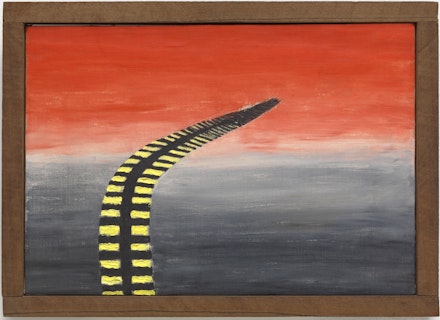Critics Page
FORREST BESS
A Visionary Artist’s Journey into Madness
For 20 years, from 1947 to 1967, a man by the name of Forrest Bess ran a bait camp on a tiny spit of land 100 feet offshore Chinquapin Bayou on the Gulf Coast of Texas. By day, he trawled for shrimp and sold them to fishermen for bait. He had the word “BAIT” painted in big letters on the side of his wooden skiff and fishermen would honk their horns or shout from a small shaky pier. Bess would get in his boat and sell them the shrimp. At night, in the two-room shack he built out of lumber salvaged from the hull of an old tugboat, he painted his visions on tiny canvases, many of them smaller than a sheet of typing paper. He claimed to have had his first vision on Easter morning when he was four years old. He devoted himself to painting them in earnest after his first breakdown when he was 33, and was haunted his entire life by the fear of madness.

He started showing his “visionary” paintings in San Antonio and Houston and was discovered by the pioneer art dealer Betty Parsons, who gave him his first show in her New York gallery in 1949. There were four more shows at the gallery, the last in 1967. These were the same years during which she was showing the giants of Abstract Expressionism and the “New York School”: Clyfford Still, Jackson Pollock, Mark Rothko, Ad Reinhardt, Barnett Newman, Ellsworth Kelly, and Agnes Martin.
His paintings got mixed reviews and few sold, but Betty Parsons believed in him as a true original, a real artist. His 1962 exhibition catalogue featured an introduction by the magisterial Meyer Schapiro, with whom Bess had been corresponding for years. He continued fishing for bait, painting, reading, and exchanging letters with such luminaries as Dr. C.G. Jung in Zurich and Dr. John Money, a prominent researcher of sexual identity, transsexuality, and genital reassignment surgery at Johns Hopkins University.
Bess described himself as “a peculiar type of homosexual.” He had no significant personal relationships with partners of either sex and never lived with anyone except his parents. In 1952, Bess made an incision on the underside of his penis with a razor blade. He was attempting to perform a secret Australian Aboriginal initiation rite on himself in order to become a “pseudo-hermaphrodite.” In 1960, Bess had another operation performed on him by a doctor to create an orifice at the base of his penis near the scrotum that would enable him to be sexually penetrated by another man.
The combination of innocence and utter conviction inherent in Bess’s little paintings is immediately and disarmingly apparent to viewers regardless of whether they know anything about his story. Their honesty, sincerity, and utter lack of irony and pretense inhere in every square inch of the canvas. He established a personal “zone,” and a way of conceiving what a painting is, how it situates itself both as a physical thing and as an object of contemplation that is unique in contemporary art. In isolation, Bess, a true follower of Van Gogh, followed his pursuit of art as a practice of self-discovery. The paintings evoke a palpable frankness, which matches the tone of his voluminous letters, and induce the immediate sensation that they were made with focus and feeling, touched with a range of emotions from exaltation to paranoia, pathos to dread, longing to utter alienation. They don’t have a predictable effect on every viewer, but some of these small images will compel one’s absorption and become unforgettably imprinted in the mind. For Bess, these paintings were sustaining proof; he staked his life on their truth to his visions. At least he did until the obsession with becoming a hermaphrodite gradually displaced his art, taking full possession of his mind.
Robert Storr concludes his essay for the 2012 Christie’s catalogue of Bess’ paintings with a thought experiment:
What place do they have in the history of modern painting? It is the place anyone dares to accord them. To locate it, run this test in your imagination. Hang a room with favorite works by Jackson Pollock, Clyfford Still, Barnett Newman, Adolph Gottlieb, Myron Stout ... and others of Bess’ generation. Alternatively pick paintings by artists who were not his contemporaries whose work has palpable affinities with his, and then select a single image by Bess to place among them. Even vastly larger canvases will be hard-pressed to keep your attention away from the diminutive intruder. Except hat Bess is not really an intruder—although he is a scene-stealer— and no longer an outsider. By right of painterly impact and poetic vision he has belonged there all along.
A traveling exhibition, Forrest Bess: Seeing Things Invisible, originating at the de Menil Collection in Houston will open at the Berkeley Art Museum on June 11 and will remain on view through September 14, 2014.
This article is excerpted from Forrest Bess: Art, Sex, Madness, an e-book soon to be released as a Kindle Single on Amazon.

